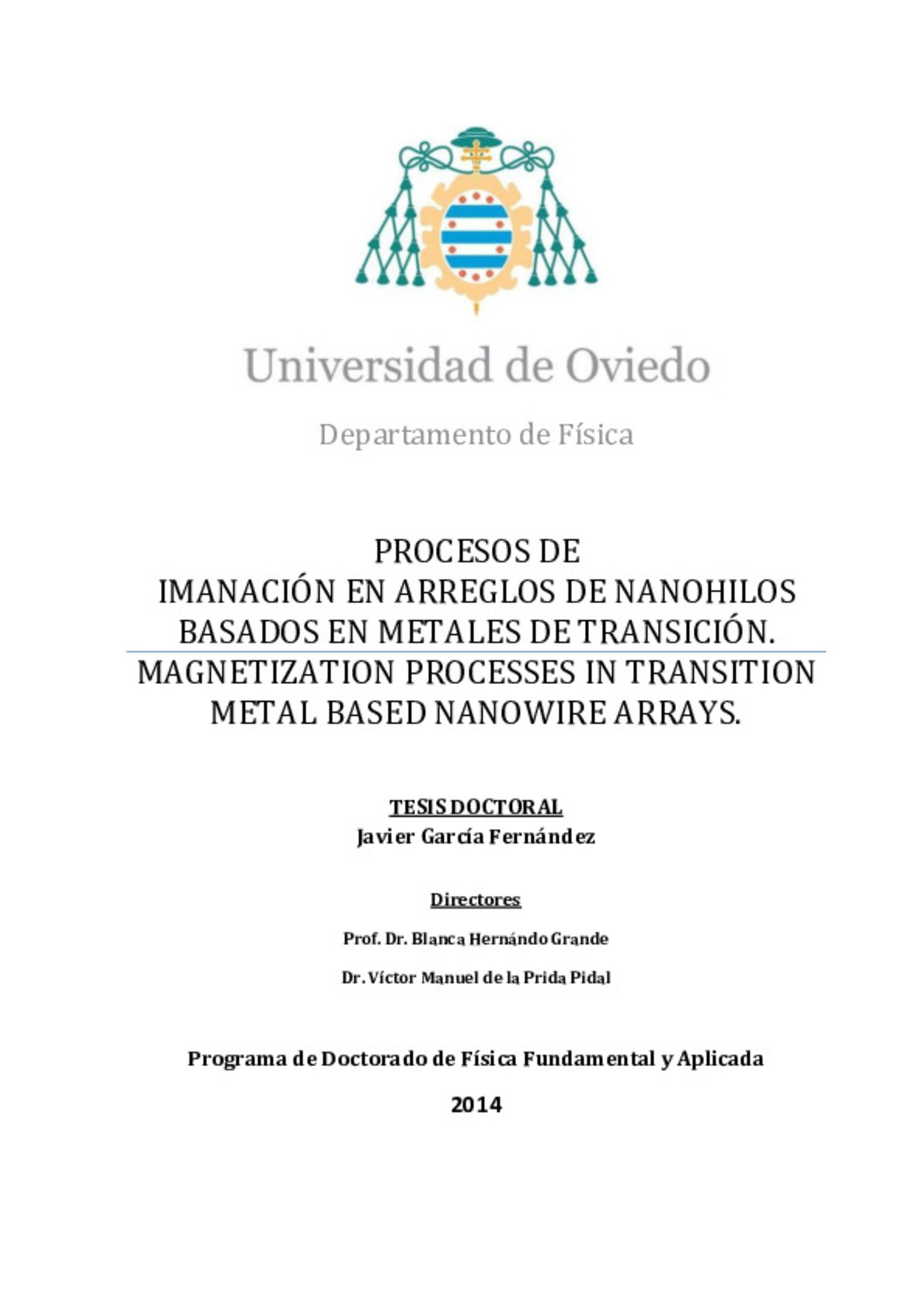Procesos de imanación en arreglos de nanohilos basados en metales de transición
Autor(es) y otros:
Director(es):
Centro/Departamento/Otros:
Palabra(s) clave:
Física fundamental y aplicada.
Magnetismo
Propiedades magnéticas de los sólidos
Electroquímica
Fecha de publicación:
Descripción física:
Resumen:
This PhD thesis focuses on the study of magnetization reversal processes and different magnetic contributions that play a key role in the magnetic behavior of nanowire arrays fabricated by means of electrodeposition into porous anodic alumina membranes (PAAMs). This work covers the fabrication and morphological, structural and magnetic characterization of these nanostructures. First of all, different electrochemical techniques employed to fabricate the PAAM templates as well as the subsequent electrodeposition of magnetic nanowires are explained in detail in order to provide a deep insight of the different characteristics for all fabricated nanomaterials. This work is also focused on the First Order Reversal Curves (FORC) analysis. This method is an excellent tool to investigate the different magnetization processes that take place during the magnetization reversal in nanowire arrays. Such tool allows obtaining intrinsic magnetic behaviors of single nanowires, and magnetic interactions among them in the array provided by macroscopic measurements employing conventional magnetometry. In this work, the FORC analysis is explained in detail and new features and real meaning of the experimental results are investigated. Moreover, in order to corroborate the experimental measurements, a computational program based on a statistical approach has been performed. The abovementioned studies on FORC have been employed in different experimental systems. First, bi-segmented nanowire arrays composed by a long segment of Ni followed by another Co segment have been fabricated and magnetically characterized. Interesting phenomena appear at the interface between both segments being exchange coupled in each nanowire. The next step has been devoted to the study of multi-segmented Co-Ni nanowire arrays by controlling the different alloy composition in each segment. Then, the composition variation and thus each segment can be correlated with different crystalline structures that modify the magnetic properties of each segment. In order to elucidate the magnetic contribution of each segment, several nanowire arrays with different stacks have been electroplated and characterized by scanning and transmission electron microscopies, X-ray diffraction and studied by performing FORC analysis. Another material presenting different magnetic behavior and structural phases is the Co-Cu system, since these elements are poorly miscible. Co-Cu nanowire arrays with different compositions have been fabricated. For a low Cu content around 8at.% two different ferromagnetic behaviors have been simultaneously observed. In addition, the corresponding fractions related to such behaviors are deduced to be interacting between them from both FORC analysis and the temperature dependence of coercivity and remanence. Finally, cylindrical porous anodic alumina membranes (CPAAM) have been employed to fabricate nanowire arrays, with different alloys based on metal transition elements, of cylindrical symmetry. The effect of the array cylindrical symmetry to the magnetic measurements have been discussed and compared with planar nanowire arrays fabricated under the same conditions. Furthermore, both experimental and simulated FORC analyses on these samples have been also performed.
This PhD thesis focuses on the study of magnetization reversal processes and different magnetic contributions that play a key role in the magnetic behavior of nanowire arrays fabricated by means of electrodeposition into porous anodic alumina membranes (PAAMs). This work covers the fabrication and morphological, structural and magnetic characterization of these nanostructures. First of all, different electrochemical techniques employed to fabricate the PAAM templates as well as the subsequent electrodeposition of magnetic nanowires are explained in detail in order to provide a deep insight of the different characteristics for all fabricated nanomaterials. This work is also focused on the First Order Reversal Curves (FORC) analysis. This method is an excellent tool to investigate the different magnetization processes that take place during the magnetization reversal in nanowire arrays. Such tool allows obtaining intrinsic magnetic behaviors of single nanowires, and magnetic interactions among them in the array provided by macroscopic measurements employing conventional magnetometry. In this work, the FORC analysis is explained in detail and new features and real meaning of the experimental results are investigated. Moreover, in order to corroborate the experimental measurements, a computational program based on a statistical approach has been performed. The abovementioned studies on FORC have been employed in different experimental systems. First, bi-segmented nanowire arrays composed by a long segment of Ni followed by another Co segment have been fabricated and magnetically characterized. Interesting phenomena appear at the interface between both segments being exchange coupled in each nanowire. The next step has been devoted to the study of multi-segmented Co-Ni nanowire arrays by controlling the different alloy composition in each segment. Then, the composition variation and thus each segment can be correlated with different crystalline structures that modify the magnetic properties of each segment. In order to elucidate the magnetic contribution of each segment, several nanowire arrays with different stacks have been electroplated and characterized by scanning and transmission electron microscopies, X-ray diffraction and studied by performing FORC analysis. Another material presenting different magnetic behavior and structural phases is the Co-Cu system, since these elements are poorly miscible. Co-Cu nanowire arrays with different compositions have been fabricated. For a low Cu content around 8at.% two different ferromagnetic behaviors have been simultaneously observed. In addition, the corresponding fractions related to such behaviors are deduced to be interacting between them from both FORC analysis and the temperature dependence of coercivity and remanence. Finally, cylindrical porous anodic alumina membranes (CPAAM) have been employed to fabricate nanowire arrays, with different alloys based on metal transition elements, of cylindrical symmetry. The effect of the array cylindrical symmetry to the magnetic measurements have been discussed and compared with planar nanowire arrays fabricated under the same conditions. Furthermore, both experimental and simulated FORC analyses on these samples have been also performed.
Notas Locales:
DT(SE) 2014-119
Colecciones
- Tesis [7596]
- Tesis doctorales a texto completo [2084]
Ficheros en el ítem





